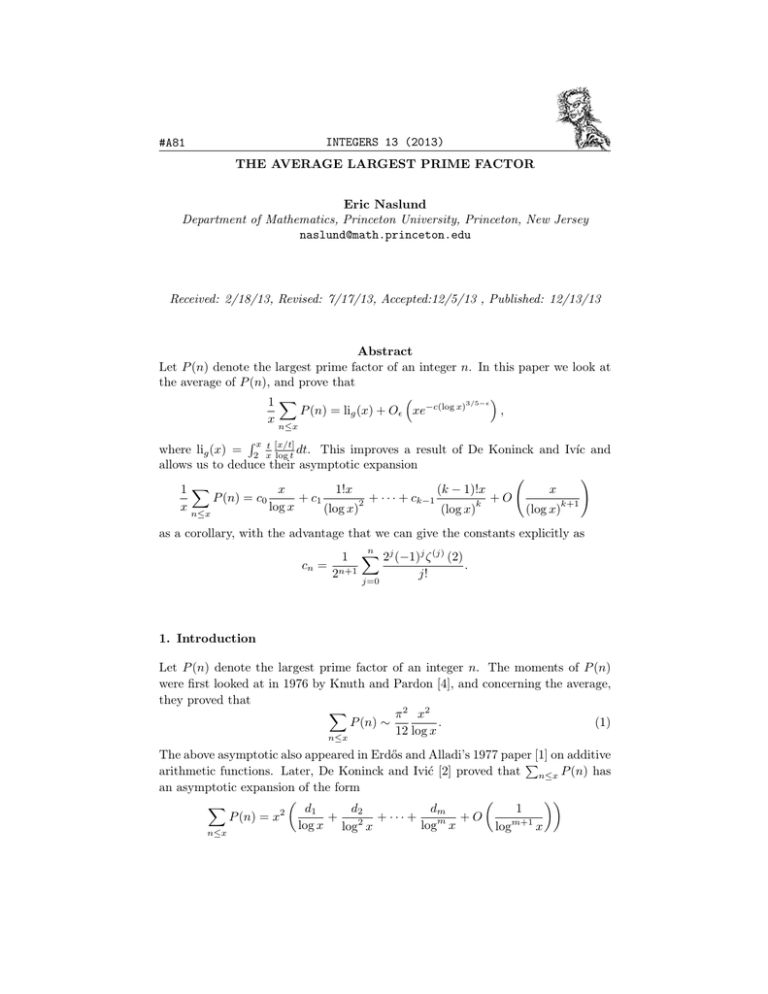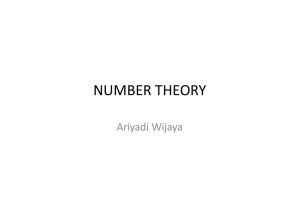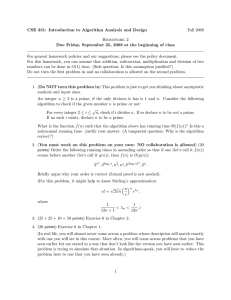INTEGERS 13 (2013) #A81 THE AVERAGE LARGEST PRIME FACTOR Eric Naslund
advertisement

INTEGERS 13 (2013)
#A81
THE AVERAGE LARGEST PRIME FACTOR
Eric Naslund
Department of Mathematics, Princeton University, Princeton, New Jersey
naslund@math.princeton.edu
Received: 2/18/13, Revised: 7/17/13, Accepted:12/5/13 , Published: 12/13/13
Abstract
Let P (n) denote the largest prime factor of an integer n. In this paper we look at
the average of P (n), and prove that
⇣
⌘
3/5 ✏
1X
P (n) = lig (x) + O✏ xe c(log x)
,
x
nx
Rx
where lig (x) = 2 xt [x/t]
log t dt. This improves a result of De Koninck and Ivı́c and
allows us to deduce their asymptotic expansion
!
1X
x
1!x
(k 1)!x
x
P (n) = c0
+ c1
+O
2 + · · · + ck 1
k
k+1
x
log x
(log x)
(log x)
(log x)
nx
as a corollary, with the advantage that we can give the constants explicitly as
cn =
1
2n+1
n
X
2j ( 1)j ⇣ (j) (2)
.
j!
j=0
1. Introduction
Let P (n) denote the largest prime factor of an integer n. The moments of P (n)
were first looked at in 1976 by Knuth and Pardon [4], and concerning the average,
they proved that
X
⇡ 2 x2
P (n) ⇠
.
(1)
12 log x
nx
The above asymptotic also appeared in Erdős and Alladi’s 1977 paper [1] on additive
P
arithmetic functions. Later, De Koninck and Ivić [2] proved that nx P (n) has
an asymptotic expansion of the form
✓
✓
◆◆
X
d1
d2
dm
1
P (n) = x2
+
+
·
·
·
+
+
O
log x log2 x
logm x
logm+1 x
nx
2
INTEGERS: 13 (2013)
where the constants di are computable, but not given explicitely. This expansion
appears again in [3], where Ivić finds a similar formula for the kth largest prime
factor.
paper,
⇣ In this3/5
⌘ we calculate the average of P (n) up to an error of the form
✏
c(log x)
O✏ xe
, like that of the prime number theorem. This allows us to
deduce De Koninck and Ivić’s expansion as a corollary, as well as give the constants
di explicitely. Our main result is:
Rx
Theorem 1. Letting lig (x) = 2 xt [x/t]
log t dt, we have that
⇣
1X
P (n) = lig (x) + O✏ xe
x
c(log x)3/5
✏
nx
⌘
.
(2)
For any integer k, lig (x) has the asymptotic expansion
x
1!x
lig (x) = c0
+ c1
2 + · · · + ck
log x
(log x)
where
cn =
1
2n+1
Notice in particular that c0 =
X
nx
⇡
12 ,
1
1)!x
k
(log x)
+O
n
X
2j ( 1)j ⇣ (j) (2)
.
j!
j=0
These constants cn satisfy cn = 1 + O
2
(k
n
2n
x
k+1
(log x)
!
(3)
(4)
.
so we deduce that
⇡ 2 x2
P (n) =
+O
12 log x
x2
2
(log x)
!
.
Although this expansion has previously been presented in [2], and again in [3],
there are some advantages to the result above. We are able to give the constants
cn explicitely in terms of the zeta function without much additional work, and our
proof is basic requiring only an application of the hyperbola method. Furthermore,
we give the explicit integral form which has an error term like that of the prime
number theorem, paralleling how ⇡(x) is approximated by the function li(x).
2. The Main Theorem
p
For each integer n x, there is ath most
i one prime p > x such that p|n, and for
each prime p there will be exactly xp integers less than x which are divisible by p.
Combining these two facts, we see that
X
X
X x
x
p
P (n)
p
,
p
p
p
x<px
nx
px
3
INTEGERS: 13 (2013)
and since
P
p
p x
p
h i
x
p
x
X
P
p
p x
P (n) =
nx
By writing
h i
x
p
Letting K(x) =
=
P
1=O
⇣
x3/2
log x
⌘
, it follows that
✓ 3/2 ◆
X x
x
p
+O
.
p
log x
(5)
px
1, and rearranging the order of summation, we obtain
X x
X
X
XX
p
=
p
1=
p.
(6)
p
x
nx: p|n
P
px
px
nx p n
nx: p|n
p, we have the estimate
Z x
⇣
t
K(x) =
dt + O✏ x2 e
2 log t
px
c(log x)3/5
✏
⌘
,
(7)
which follows from the prime number theorem (See [5]) along with partial summation. Using (7) along with equations (5), and (6), we have that
!
✓ 2
◆
3
X
X Z nx t
X
2
x 3/5 ✏
x
x
c(log n
)
P (n) =
dt +
O✏
e
+O
log t
n2
log x
nx
nx 2
nx
⇥
⇤
Z x x
⇣
⌘
t t
3/5 ✏
=
dt + O✏ x2 e c(log x)
(8)
2 log t
⇣
⌘
3/5 ✏
= xlig (x) + O✏ x2 e c(log x)
,
(9)
which proves (2). To recover the asymptotic expansion in (3), we turn our attention
to this integral function and make the substitution t = ux to obtain
⇥ ⇤
Z
Z x/2
1 x t xt
[u]
lig (x) =
dt = x
du.
(10)
3 log x
x 2 log t
u
1
u
We can rewrite the integral above as
✓
Z x/2
Z x/2
[u]
1
[u]
du
=
1
log x 1
u3
u3 log ux
1
log u
log x
◆
1
du,
and for any integer k 1, by the geometric series expansion
✓
◆ 1
✓
◆k 1 ✓
◆k ✓
log u
log u
log u
log u
1
=1+
+ ··· +
+
1
log x
log x
log x
log x
we have that
Z x/2
1
[u]
u3 log
x
u
du =
k
X1
n=0
+
1
n+1
(log x)
1
k+1
(log x)
Z
Z
1
log u
log x
◆
1
x/2
1
x/2
[u]
n
(log u) du
u3
✓
◆
[u]
log u
k
(log u) 1
u3
log x
1
du.
,
4
INTEGERS: 13 (2013)
Each of these integrals is absolutely convergent
⇣
⌘ on [1, 1), and so Rthe last term con1 [u]
k
1
1
tributes an error term of at most Ok logk+1
. Setting ck = k!
(log u) du,
1 u3
x
and applying the bound
✓
Z 1
Z 1
n
n◆
[u]
(log u)
(log x)
n
(log u) du
du = O
,
3
u2
x
x/2 u
x/2
it follows that
lig (x) =
✓
◆
k 1
x X n!cn
x
+
O
.
k
log x n=0 (log x)n
logk+1 x
(11)
To evaluate these constants cn , we use exponential generating series. Integration
by parts tells us that for s > 1
Z 1
Z 1
1
X
s
s
⇣(s) =
n =
x d [x] = s
[x] x s 1 dx,
1
n=1
and so
1
X
k
ck z =
Z
1
1
1
k=0
[x] xz
3
dx =
⇣(2 z)
.
2 z
Multiplying the power series expansions for ⇣(2 z) and 2 1 z yields
0
1
0
1
!
1
1
1
j
k
(j)
X
X
X
X
z
1
⇣ (2) 1 A
@ ( 1)j ⇣ (j) (2) z A 1
=
zn @
( 1)j
,
k
j!
2
2
2
j! 2k
n=0
j=0
k=0
k+j=n
and hence
cn =
1
2n+1
To find the size of cn we note that
( 1)j ⇣ (j) (2)
j!
=
=
1
n
X
2j ( 1)j ⇣ (j) (2)
.
j!
j=0
j
1 X (log k)
j!
k2
k=1
Z
Z
j
1 1 (log x)
1 1 (j
dx
+
j! 1
x2
j! 1
2 log x) logj
x3
1
x
{x} dx.
Substituting x = eu , the first integral becomes (j + 1), and the second is O
which implies that
✓ ◆
( 1)j (j)
1
⇣ (2) 1 = O
,
j!
2j
and so cn = 1 + O
n
2n
⇣
j!
2j
⌘
,
. This establishes all of Theorem 1.
Acknowledgment I am grateful to Greg Martin for his suggestions and encouragement.
INTEGERS: 13 (2013)
5
References
[1] K. Alladi and P. Erdős. On an additive arithmetic function. Pacific J. Math. 71(2):275–294,
1977.
[2] Jean-Marie De Koninck and Aleksandar Ivić. The distribution of the average prime divisor of
an integer. Arch. Math. (Basel) 43(1) (1984), 37–43.
[3] Aleksandar Ivić. On the kth prime factor of an integer. Zb. Rad. Prirod.-Mat. Fak. Ser. Mat.
20(1) (1990), 63–73.
[4] Donald E. Knuth and Luis Trabb Pardo. Analysis of a simple factorization algorithm. Theoret.
Comput. Sci. 3(3) (1976/77), 321–348.
[5] Hugh L. Montgomery and Robert C. Vaughan. Multiplicative number theory. I. Classical
theory, volume 97 of Cambridge Studies in Advanced Mathematics. Cambridge University
Press, Cambridge, 2007.









